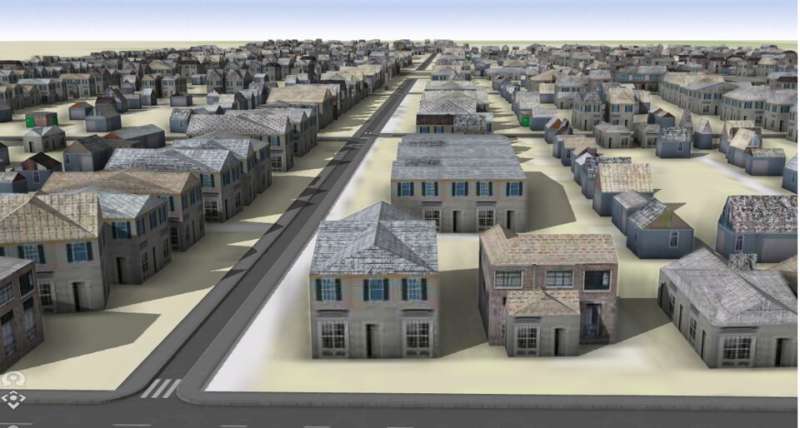This article has been reviewed according to Science X's editorial process and policies. Editors have highlighted the following attributes while ensuring the content's credibility:
fact-checked
peer-reviewed publication
trusted source
proofread
Turning old maps into 3D digital models of lost neighborhoods

Imagine strapping on a virtual reality headset and "walking" through a long-gone neighborhood in your city—seeing the streets and buildings as they appeared decades ago.
That's a very real possibility now that researchers have developed a method to create 3D digital models of historic neighborhoods using machine learning and historic Sanborn Fire Insurance maps. The study was published in the journal PLOS ONE.
But the digital models will be more than just a novelty—they will give researchers a resource to conduct studies that would have been nearly impossible before, such as estimating the economic loss caused by the demolition of historic neighborhoods.
"The story here is we now have the ability to unlock the wealth of data that is embedded in these Sanborn fire atlases," said Harvey Miller, co-author of the study and professor of geography at The Ohio State University.
"It enables a whole new approach to urban historical research that we could never have imagined before machine learning. It is a game changer."
This research begins with the Sanborn maps, which were created to allow fire insurance companies to assess their liability in about 12,000 cities and towns in the United States during the 19th and 20th centuries. In larger cities, they were often updated regularly, said Miller, who is director of Ohio State's Center for Urban and Regional Analysis (CURA).
The problem for researchers was that trying to manually collect usable data from these maps was tedious and time-consuming—at least until the maps were digitized. Digital versions are now available from the Library of Congress.
Study co-author Yue Lin, a doctoral student in geography at Ohio State, developed machine learning tools that can extract details about individual buildings from the maps, including their locations and footprints, the number of floors, their construction materials and their primary use, such as dwelling or business.
"We are able to get a very good idea of what the buildings look like from data we get from the Sanborn maps," Lin said.
The researchers tested their machine learning technique on two adjacent neighborhoods on the near east side of Columbus, Ohio, that were largely destroyed in the 1960s to make way for the construction of I-70.
One of the neighborhoods, Hanford Village, was developed in 1946 to house returning Black veterans of World War II.
"The GI bill gave returning veterans funds to purchase homes, but they could only be used on new builds," said study co-author Gerika Logan, outreach coordinator of CURA. "So most of the homes were lost to the highway not long after they were built."
The other neighborhood in the study was Driving Park, which also housed a thriving Black community until I-70 split it in two.
The researchers used 13 Sanborn maps for the two neighborhoods produced in 1961, just before I-70 was built. Machine learning techniques were able to extract the data from the maps and create digital models.
Comparing data from the Sanford maps to today showed that a total of 380 buildings were demolished in the two neighborhoods for the highway, including 286 houses, 86 garages, five apartments and three stores.
Analysis of the results showed that the machine learning model was very accurate in recreating the information contained in the maps—about 90% accurate for building footprints and construction materials.
"The accuracy was impressive. We can actually get a visual sense of what these neighborhoods looked like that wouldn't be possible in any other way," Miller said.
"We want to get to the point in this project where we can give people virtual reality headsets and let them walk down the street as it was in 1960 or 1940 or perhaps even 1881."
Using the machine learning techniques developed for this study, researchers could develop similar 3D models for nearly any of the 12,000 cities and towns that have Sanborn maps, Miller said.
This will allow researchers to re-create neighborhoods lost to natural disasters like floods, as well as urban renewal, depopulation and other types of change.
Because the Sanborn maps include information on businesses that occupied specific buildings, researchers could re-create digital neighborhoods to determine the economic impact of losing them to urban renewal or other factors. Another possibility would be to study how replacing homes with highways that absorbed the sun's heat affected the urban heat island effect.
"There's a lot of different types of research that can be done. This will be a tremendous resource for urban historians and a variety of other researchers," Miller said.
"Making these 3D digital models and being able to reconstruct buildings adds so much more than what you could show in a chart, graph, table or traditional map. There's just incredible potential here."
More information: Creating building-level, three-dimensional digital models of historic urban 1 neighborhoods from Sanborn Fire Insurance maps using machine learning, PLoS ONE (2023). journals.plos.org/plosone/arti … journal.pone.0286340
















